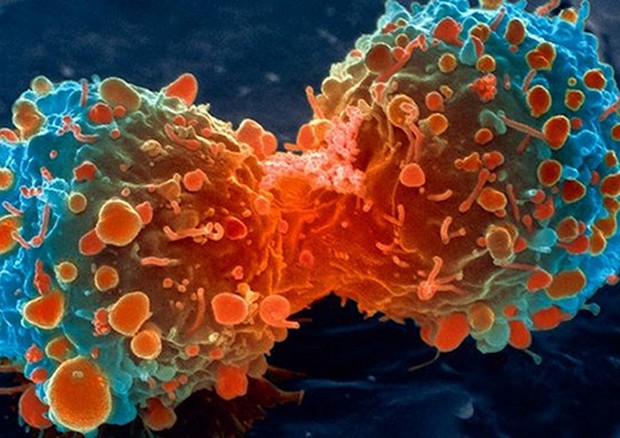Tumori, trovato il codice di autodistruzione delle cellule / Tumors, found the code of cell self-destruction
Tumori, trovato il codice di
autodistruzione delle cellule /
Tumors, found the code of
cell self-destruction
Segnalato dal Dott. Giuseppe Cotellessa /
Reported by Dr. Giuseppe Cotellessa

Cellula del tumore del polmone in fase di divisione / Lung
cancer cell undergoing division (fonte: National Institutes of
Health) © ANSA/Ansa
Non solo in quelle malate, può diventare nuova arma 'naturale'
Trovato il codice di autodistruzione delle cellule: in futuro potrebbe diventare la chiave per cure anticancro mirate al punto da 'spingere al suicidio' soltanto le cellule tumorali, senza danneggiare quelle sane. Pubblicata sulla rivista Nature Communications, la scoperta arriva dall'americana Northwestern University. Proprio come la stringa di informazione di un software, il codice è racchiuso nelle istruzioni di ogni cellula dell'organismo e diventa attivo quando le cellule si trasformano a causa di un tumore.
Il codice di autodistruzione delle cellule è incorporato in una proteina antica più di 800.000 anni, la cui funzione è proteggere l'organismo dal cancro. Per farlo controlla la produzione della molecola di Rna, il braccio destro del Dna, e dei micro Rna, le piccole sequenze di geni che come registi regolano l'espressione di altri geni. "Adesso che conosciamo il codice, possiamo far scattare il meccanismo senza dovere più ricorrere alla chemioterapia e senza interferire con il genoma", osserva il coordinatore della ricerca, Marcus Peter.
Conoscere il codice significa infatti poter controllare le armi anticancro, ossia i micro Rna che l'organismo utilizza normalmente per difendersi e attivarle per aggredire le cellule malate. "Possiamo utilizzare i micro Rna direttamente e schiacciare l'interruttore che innesca l'autodistruzione", aggiunge Peter. La nuova strategia offre anche il vantaggio di non avere i numerosi effetti collaterali della chemioterapia, che alterando il genoma delle cellule rischia di provocare tumori secondari. L'obiettivo adesso, spiega Peter, "non è trovare una nuova sostanza artificiale tossica per il tumore", ma "seguire il corso della natura, utilizzando un meccanismo che la natura ha sviluppato".
ENGLISH
Found the code of self-destruction of cells: in the future it could become the key to anticancer care aimed at the point of 'pushing only the cancer cells to suicide, without damaging the healthy ones. Published in the journal Nature Communications, the discovery comes from the American Northwestern University. Just like the information string of a software, the code is enclosed in the instructions of every cell of the organism and becomes active when the cells are transformed due to a tumor.
The cell self-destruct code is incorporated into an ancient protein over 800,000 years, whose function is to protect the body from cancer. To do this, it controls the production of the Rna molecule, the right arm of the DNA, and the micro Rna, the small sequences of genes that regulate the expression of other genes. "Now that we know the code, we can trigger the mechanism without having to resort to chemotherapy and without interfering with the genome," observes the research coordinator, Marcus Peter.
Knowing the code means in fact being able to control the anti-cancer weapons, ie the micro RNA that the body normally uses to defend itself and activate them to attack the diseased cells. "We can use the micro RNA directly and crush the switch that triggers self-destruction," adds Peter. The new strategy also offers the advantage of not having the numerous side effects of chemotherapy, which by altering the cell genome risks causing secondary tumors. The goal now, explains Peter, "is not to find a new toxic substance for the tumor", but "to follow the course of nature, using a mechanism that nature has developed".
Da:



Magnifico!
RispondiElimina